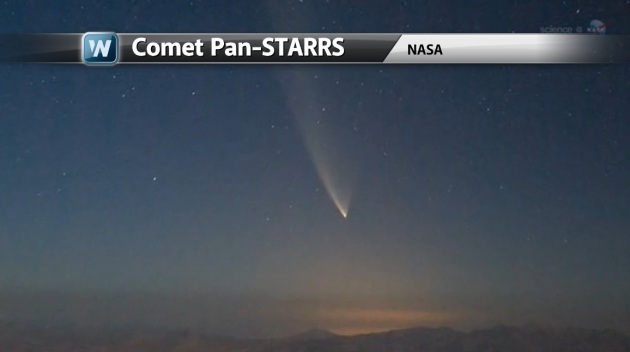Archive for the ‘Comets’ Category
Comet Lovejoy
If you are currently lucky with the weather (we are not in Plymouth!), you should be able to see Comet Lovejoy (Comet C/2014 Q2 Lovejoy) in the night sky now. Ideally, it is best to go to a dark area, such as a moor or rural location, as it will be much easier to see it, although you will probably be able to make it out with the naked eye in a more built up area. The very best way to view it would be to go to a really dark place and have a look at it through some binoculars. It will appear like a glowing green blue ball, due to the fact it is made of ice.
The comet was only discovered last year by an Australian astronomer called Terry Lovejoy, but it has been found to have been orbiting the Sun and is about 44 million miles away from the Earth (as of now). So there is no chance that it will hit us! 😉 The last time it came through our part of the Solar System was 11,500 years ago and it won’t be back for another 8,000 years. We will all be travelling around in space by then I think! It appeared closest to Earth on January 7th, but is still going to be a really good view for at least another 10 days, until it will gradually get fainter and fainter as it moves further away from us.
To find Comet Lovejoy in the Sky, you will need to look towards the South of the Constellation Taurus and to the West of the upper half of the Constellation Orion. As the days go on, it will obviously travel onwards and eventually through the edge of Taurus and near to the Pleiades. It should be pretty straight forward to spot if you know your basic Constellations.
This is a great Comet to view and I am crossing my fingers that our skies clear enough for me to have a good look at it! 😉
Lyrids Meteor Shower 2014
For the Lyrids Meteor Shower this year, the Moon is going to keep the sky quite light, which will make it much harder to see them. Saying that, it should still be possible, especially when they are at their peak on the 23rd April. I say this as I happened to be outside this past Tuesday night, watching the ISS fly over Plymouth, and to my surprise, whilst it was moving through Ursa Major (specifically the Plough part of the constellation), there were 5 or 6 tiny little explosions going off in the sky nearby. I couldn’t quite believe it really and it put me off watching the ISS (which I always find fascinating!).
I watched for several more minutes and saw several other meteors in the sky, in the general area of the sky off to the left of Ursa Major. These were not massive meteors as far as I could tell, as you only saw them for a split second, but this was probably due to the almost full moon which was keeping the sky bright and hiding all but the most brightest stars. These weren’t like the tiny explosions I saw during the ISS flyover, but more meteor like. I can only presume these were the Lyrids and the first batch I saw were so small and didn’t ‘shoot across the sky’ but burnt up as soon as they hit the atmosphere of the Earth. The second batch must have been slightly bigger and lasted longer when hitting the atmosphere. Either way, it was great viewing!
The Lyrids Meteors emanate from the constellation Lyra (hence their name) and they are part of the comet Thatcher that takes about 415 years to orbit the Sun. The peak of the shower is usually around the 21st to the 24th of April but they can be seen for several days before and after, depending on how lucky you are! I guess I was very lucky the other night!
Enjoy the Lyrids Meteor Gazing!! 😉
Eta Aquarids Meteor Shower 2013
For those of you who are very early risers in the morning, the Eta Aquarids Meteor Shower is for you! Unfortunately, for those of us who can’t get up in the morning we will probably miss this shower, as the best time to view these meteors is in the couple of hours before dawn. This is when the radiant of the meteor shower comes over our horizion in the Northern Hemisphere.
The good thing about this meteor shower is that you can see the meteors several days before the peak, which is on May 5th, and then for several days after. I believe the full timescale is from the 19th April until the 28th May, so they can be seen for over a month, if you are willing to get up in the morning! The number of meteors that should be seen each hour could peak at about 70 per hour if you are lucky, but you are more likely to see around 10-20 per hour in the Northern Hemisphere, with each meteor travelling at approx 66km/s. This year is actually a very good year to view the Eta Aquarids as the moon is only a waning crescent so will not make the sky too bright.
This meteor shower is called the Eta Aquarids as the radiant of the shower looks to emanate from the star Eta in the constellation of Aquarius. Aquarius is also known as the ‘Water Bearer’ and is shown in the image below. The meteors from this shower are actually dust and debris left behind from Halleys Comet, with this shower coming about due to the Earth passing through this orbital path of the Comet and thus ploughing straight through the path of debris
Comet Spotting – Attempt #3
Last night we went out again to try and find Comet Pan-Starrs as it was a clear night, but unfortunately, we didn’t manage to see it. There was a band of cloud along the horizon where I am sure the Comet would have been, and it was also very frosty so the atmosphere of the Earth wasn’t as clear as it had been the previous nights when we have been out. It was a bit of a shame, but we at least saw the Comet on our second attempt which was great!
Instead last night, we had a look around at the other objects in the Sky with our binoculars. Jupiter was very bright and you could see a couple of it’s Moon’s shining beside it, and we also had a good look at the Pleiades (also known as the ‘Seven Sisters’ as they are a group of seven stars that shine very brightly. The Pleiades were clear as a bell through the binoculars and were a great site! Finally, we had a go at looking for the Orion Nebula and that was showing really well. You could see a blurry, but large, mass of stars which make up the Nebula in the sword of the Constellation Orion (just south of Orion’s belt). It was a great view!
So whilst we were annoyed we couldn’t see the Comet again, we had a good time looking at some of the other features that make up the night sky!
Comet Spotting – Attempt #2 – SUCCESS!
After not being sure if we would make it out this evening due to Kelly being ill all last night and this morning and the strange weather that we have had today (rain, sleet, hail and snow!), we did manage to go out, and I am very glad that we did as we spotted the Comet!! 😉
Instead of going to Jenny Cliff, we made the shorter journey up to Shaugh Prior on Dartmoor, as we knew of a good vantage point there, and arrived shortly after sunset (about 18:30 with sunset being 18:18). The Moon was a lot higher in the Sky tonight than last night, and a lot easier to spot as it was a much brighter crescent. So we had a good look around it but couldn’t see anything to start with and it took about 25-30 minutes to spot anything remotely that looked like a Comet.
When I did finally spot something, the object that I saw was very slowly moving across the Sky horizontally and in the general area of where we thought the Comet ought to be. It also had a very long but dark smoky tail but the head of it didn’t have any lights or a brightness to it. We honestly didn’t (and still don’t) know what this object was – it definitely wasn’t an Airplane – it looked more like a meteor to me but who knows!!
At about 19:10 I decided to have one final look (it was absolutely freezing cold) and just had a general scan of the Sky underneath and around the Moon, and finally spotted it! It was very faint and to the lower right of the Moon (not to the lower left as on previous nights) but it was unmistakeable. You could see the head of the Comet being lit up by the Sun and the long tail reaching out behind it almost vertically. We couldn’t see the twin tail unfortunately, but we were very glad that we finally saw it after nearly giving up! It was a very exciting 10-15 minutes looking at it (whilst a Tawny Owl was calling in the nearby trees which did make it a bit creepy though!).
Here is an image from NASA that looks almost exactly the way we saw it, although it wasn’t quite as bright as this tonight.
Tomorrow is the last day of decent weather for the next few days, so we will be going out again to Shaugh Prior to have another look. Am hoping we will get an even better view of it! 😉


